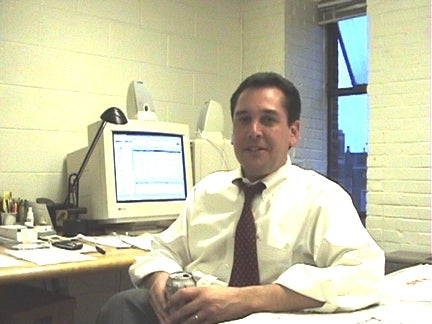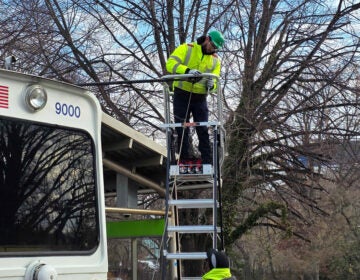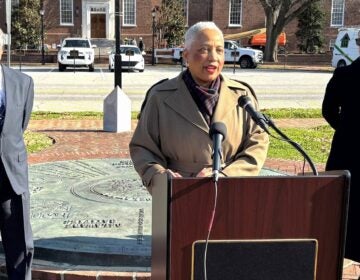A Q&A with PennPraxis Director Harris Steinberg

A Q&A with PennPraxis Director Harris Steinberg
By Matt Blanchard
For PlanPhilly
In October 2006, Philadelphia Mayor John Street issued an executive order authorizing urban planning consortium PennPraxis to spearhead a democratic effort to create a lasting public design legacy along seven miles of the Delaware River’s central waterfront.
At the tip of that spear is Praxis executive director Harris Steinberg, a native-born Philadelphian and a passionate advocate for thoughtful use of city space. In the following interview, Steinberg explains what the public can expect from this unique planning effort, and why he’s determined to mobilize the imaginations of every Philadelphian toward a common vision for our waterfront.
As the plan takes shape, Steinberg promises a blockbuster public exhibition that can inspire politicians, developers and the people to do what’s right with our riverfront. And he’s not joking when he says Delaware Avenue could become “one of the greatest boulevards in the world.”
Steinberg earned an undergraduate degree in History from Penn in 1978 and returned in 1982 for a graduate degree in Architecture. He has been the executive director of PennPraxis since its inception in 2001.
Question: What exactly is PennPraxis and what does it bring to this effort that no one else can?
Answer: PennPraxis is the clinical arm of the school of design here at Penn. We are in business – just like clinical arms of the dental school, law, medicine – to create opportunities for faculty and students to do real world problem solving. We’ve worked on projects around the world, around the nation, and across the disciplines of architecture, landscape architecture, historic preservation and city and regional planning.
We’ve been working over the past five years now, in places as close to home as Penn’s campus, looking at new ways of storing bicycles on campus, or working with the Village of Arts and Humanities on a plan for shared prosperity in North Philadelphia. We have done work in Pittsburgh on the conservation of cathedral windows, urban planning work in Granada, Spain, Singapore and Taiwan. PennPraxis is a multi-disciplinary global practice attached to one the best design schools in the country, if not the world. The objective is to harness the resources of the academy and put them to good use on real world problems outside the walls of the academy.
My own particular interest at Praxis is civic engagement, and that’s what this project is about. That’s why we are unique in the city, and that’s why we were asked to do this project.
Q: Can you talk about that concept in more detail?
A: Civic engagement is figuring out ways that we as a society and we as a university and the newspapers can convene large public conversations around thorny development issues. So we’ve worked with the Philadelphia Inquirer’s editorial page editor Chris Satullo to convene a public debate over Penn’s Landing. We’ve also worked with columnist Sandra Shea at the Philadelphia Daily News for a project on the impact of casinos in Philadelphia. These are large development issues; big money, big politics.
Q: So what form will this waterfront plan actually take? It might be obvious to professionals like you, but most people think in terms of buildings, parks, pathways, not plans. They think in terms of the elements – not the plan.
A: Planning takes big strokes and little strokes. You’ve got to have both. I like to imagine that Delaware Avenue becomes one of the greatest boulevards in the world. Just using the term “boulevard” elevates it from an industrial port route to something that has a civic character, that is ceremonial, that is a great public space. We should be able to line Delaware Boulevard with shops and cafes and galleries and housing, that face elegant open spaces, where we can go out on the river in boats.
And it doesn’t have to be a class issue, because really it’s about everyone having access. Just think of New York City, 5th Avenue. My parents grew up in Brooklyn. But using the New York Public Library on 5th Avenue was one of the greatest joys in the world, because it was the everyman’s palace. I think that’s ultimately what we want to create, a public realm along the water that is so Philadelphian that all of us feel comfortable there. It’s with that sort of imagery that we need to paint our future.
Q: Knowing that the planning process has only just begun, I’m wondering how specific you can be about the elements that might be part of any new Philadelphia waterfront. Boat marinas? Parks? A continuous riverfront path?
A: All of those sound great. I can’t really say. My responsibility is to the voice of the people, who will ultimately tell us that. Ideas that I’ve heard include all of those. There is, of course, private land on the waterfront. There are parts that are inaccessible, that the Port Authority controls or that Homeland Security controls. We’re going to have to knit together some sort of public realm that has a quality that is uplifting, and demonstrates that quality of life matters here. But exactly what that will look like, I couldn’t tell you.
Q: When we talk about vision for the waterfront, are there other cities you look to for inspiration?
A: New York, of course, is one of them. They have some great success stories, and they probably have some cautionary tales as well. Other cities are Barcelona, Vancouver, Boston, Rotterdam, Melbourne, and Liverpool. There are definitely models to look at. And part of our work will be only bringing the best practices from around the globe to the people of Philadelphia through public forums and our website.
But this has to be Philadelphia. One of the greatest lines that came out of the Penn’s Landing public forum was “Inner Harbor Envy,” referring to Baltimore’s waterfront. For decades, we labored under “If only we could bring an Inner Harbor to Philadelphia.” Well damn it, we’re Philadelphia. I don’t give a hoot about Baltimore. It’s a nice little place, but we’ve got to make this Philadelphia. We have the resources, the talent, the drive, and the right alignment of political and civic will to do something that’s us. We invented waterfront designs and planning in 1812 at the Waterworks. Fairmount Park was the first of its kind. The Wissahickon was the first of its kind. We have the ability to do this right in our DNA.
Q: When will we start to see some ideas get generated?
A: We’re starting with “value sessions,” where citizens come together and talk about personally what’s important to them about the waterfront, and then collectively as a neighborhood, and then as a city. Ideas will certainly emerge there. And we’ve heard some of these things already.
For a lot of people, having a working shipping port is an incredibly important part of the economy and their identity, and they don’t want it touched. Others value access to the water for recreation. Others value commercial development. There are things starting to surface. People are just beginning to kind of feel their way in to it. But the potential for this to be something different, something special, is really there.
There are four basic elements in a plan like this one. There’s water access, the character of Delaware Boulevard, the connections from the water back to the neighborhoods, and then there’s the quality of the buildings. What do they look like? Does anything go? Should a 900-foot tower be next to a 6-story building?
Within those four elements there are subsets: The natural systems are one. It turns out that scores of little creeks that have been buried in culverts run through the neighborhoods, some of which might be able to be restored, or their marshlands recreated. Another issue is sustainable development, because green development these days is a big interest. All these things are pieces in the superstructure of this plan. There’s also public art, which affects what I call the character of the boulevard.
It all starts with the “public realm”. That’s the public spaces. Developers don’t quite get what public realm is. When you go to King of Prussia Mall, that’s not public, that space is controlled by the developer. We don’t want the developers to control the public realm. We want the public to control the public realm.
So the public realm must be defined first. In that respect, William Penn’s plan for Philadelphia is our mantra. It had five public squares, forever public, no one touches them, and all development went on around them. That’s what we’re going to do here. We have to figure out: what are our public squares down there? And what character will they have? The quality and character of the squares down there will enhance the value of the land around them.
Developers should not feel threatened by the creation of a quality public realm. We’d love to get broad based buy-in to this – it’s good for everybody. We’re not trying to shove anything down anybody’s throat. If somebody doesn’t want to play, we go around them. This is not Robert Moses coming in with bulldozers, and saying this is going to be a park. But it is coming to some common set of principles, and building an armature around these principles that can structure future development on the waterfront.
Q: You have said the planning process will culminate in a blockbuster public exhibition of ideas for our waterfront. You’re hoping half a million people will attend. Is there any precedent for such an exhibition in Philadelphia?
A: Yes there is. Sixty yeas ago Edmund Bacon, the legendary director of the Planning Commission, put together an exhibition called the Better Philadelphia Exhibition, which covered 2 floors of Gimbel’s department store. It showed the transformation of Center City Philadelphia. From a choked industrial 19th century, Bacon was creating the 20th century city, with models – at the time they were high tech — that flipped up to show a gleaming Penn Center, Society Hill, Independence Mall. The exhibition drew 385,000 people. Today we’re setting the bar higher. I‘d like to drive about 500,000 people through our exhibition.
Even earlier, when the Ben Franklin Bridge was being built, the models of the towers that hold the bridge span were on display in the City Hall courtyard. Models of the Parkway were on display in City Hall. Things of a great civic nature need that kind of popular display and buy-in. There is precedent for it in Philadelphia.
Q: But a skeptic might point out that even the best plans get ignored. What gives you the confidence that this plan, once completed, will be carried out?
A: There’s no guarantee. Our strategy is to engage as broad a public as possible: citizens, government officials, developers, academics – ultimately to create a civic will that makes it easy for policy makers to wrap their hands around it and say: “This is the will of the people.”
We don’t represent any vested interest here. As a university-based office, whose ultimate goal is excellence and quality of life in the city of Philadelphia, what we bring to the table is a degree of neutrality, and a reputation as an honest broker. We’re completely paid for by foundation funding. The city is not paying us. The city has authorized us to do our work, but we’re not paid by them or beholden to them. In fact, our funding requires that this be an open, transparent process accountable to the public.
So our audience is the people of Philadelphia. Our charge is to work with an advisory group set up by the mayor, but our client is the people of Philadelphia. All of our effort will go to broadcasting this as far and wide as possible, to include as many people as possible.
Our exhibition, with models and videos, will be the work of the people. We hope to make it on the scale of the PMA’s Cezanne exhibition, so that it truly is a popular ratification of an ideal and can serve as a roadmap for multiple generations to come. This ideal can change and evolve, but ultimately we want to say: “This is what we as a people want.”
Matt Blanchard graduated Penn Urban Studies in 1997. A former reporter for the Philadelphia Inquirer, he now teaches writing at the University of the Arts. Matt will be a regular contributor to PlanPhilly.
WHYY is your source for fact-based, in-depth journalism and information. As a nonprofit organization, we rely on financial support from readers like you. Please give today.






